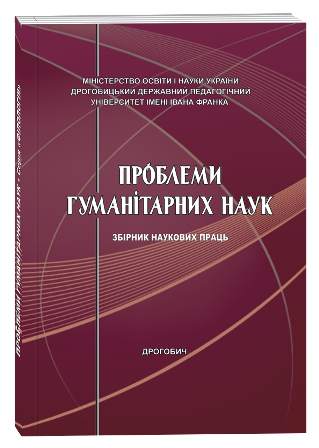«Є РЯДКИ ПІСЕННІ ВІЧНІ Й РИМИ В НИХ – ОМОНІМІЧНІ»
DOI:
https://doi.org/10.24919/2522-4565.2023.56.2Ключові слова:
омонімічна рима, омоніми, омопари, слово, значення.Анотація
Анотація. У статті відповідно до мети окреслено лексико-семантичне й функційно-прагматичне навантаження омонімів в омонімічних римах; уточнено сутність понять омонімічна / тавтологічна рима в лінгвістичному ракурсі, з’ясовано їх диференційні ознаки. Методологія. Дослідження ґрунтовано на потрактуванні й диференціації омонімічних і тавтологічних рим у парадигмі вітчизняної лінгвістичної римології (лінгвокогнітивний підхід), описі омонімічних рим у формальних і лексико-семантичних зв’язках (системно-структурний підхід), розгляді омонімічних римокомпонентів в аспекті звукового, смислового, функційного і прагматичного потенціалу (функційно-прагматичний підхід). Новизна. Уперше оприявнено дискусійні моменти лінгвістичної теорії омонімічної рими; запропоновано їх типологію на основі лексико-семантичного й граматичного критеріїв; омовлено прагматичні настанови, пов’язані з функційним навантаженням римокомпонентів і проблемами їх перекладу. Висновки. Попри наявні спроби багатоаспектного аналізу проблематики лінгвістичної римології, репрезентацію римового простору через складне переплетіння римових зв’язків, залишається ще чимало дискусійних моментів. До таких уналежнено й суперечності щодо лінгвістичного витлумачення понять «омонімічна рима» / «тавтологічна рима», з’ясування їх сутності, інтегральних і диференційних ознак. Яскравим ілюстративним матеріалом для розв’язання окреслених проблем можуть слугувати двовірші Б. Кравцева, що об’єднані під назвою «Тавторими» і які насправді засвідчують зразки не тавтологічних, а омонімічних рим. Римовані омопари не є однорідними ні в плані лексико-семантичних, ні в плані граматичних характеристик, що уможливлює диференціацію омоформних, омофонних, омографних рим, компоненти яких демонструють різну частиномовну належність.
Посилання
Діброва С. М. Передмова. Словник рим Т. Г. Шевченка. Сімферополь, 2004. С. 3–9.
Дудик П. С. Стилістика української мови : навч. посіб. Київ : Вид-во «Академія», 2005. 368 с.
Космеда Т. А. Мовна гра в парадигмі інтерпретативної лінгвістики. Граматика оцінки. Граматична ігрема (теоретичне осмислення дискурсивної практики) : монографія. Дрогобич : Коло, 2013. 228 с.
Кравців Б. Тавторими. Зібрані твори: у 3 т. Т 1. Поезія. Нью-Йорк, 1978. С. 247–270.
Мацько Л. І., Сидоренко О. М., Мацько О. М. Стилістика української мови : підручник. Київ : Вища школа, 2003. 462 с.
Мовчун Л. В. Українська рима в системі мови і в мовній практиці : монографія. Київ : Інститут української мови НАН України, 2020. 472 с.
Різників О. Одноримки. Словник омонімів та схожословів. 2-ге вид., доп. і перероб. Тернопіль : Богдан, 2011. 408 с.
Кабиш М. Ю. Звукопис в українській поезії першої половини ХХ століття: семантика, функції : дис. … канд. філол. наук. Київ, 2015. 267 с.
Літературознавчий словник-довідник / Р. Т. Гром’як, Ю. І. Ковалів та ін. Київ : Академія, 1997. 749 с.
Hanson K. Rhyme. Encyclopedia of Language and Linguistics. 2nd ed. Vol. 10. Kidlington, Oxford : Elsevier Ltd., 2006. P. 605–616.
Rhyme and Rhyming in Verbal Art, Language, and Song / Venla Sykäri, Nigel Fabb. Helsinki : Finnish Literature Society (SKS), 2022. 229 р.



